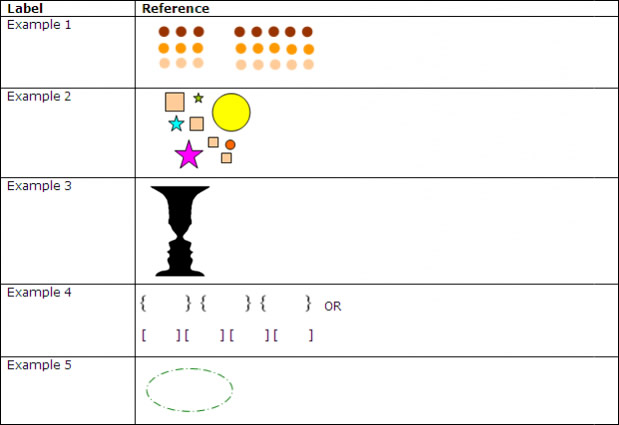This week I focus on how a basic understanding of the Gestalt principles can help create harmonious design and improve the odds that the intended message is conveyed to the learners we design for.
The Theory
The Gestalt theory suggests that when a person looks at an intricate combination of elements, the “whole” is perceived before its “individual” parts. Consequently, the “whole” also becomes more than the sum of its parts. To put it simply, the theory refers to how visual input is perceived by humans.
Look at these examples. We’ll then look at some of the Gestalt principles and relate how you “perceived” these designs.

Let’s begin with the laws now:
1. Law of Proximity: The law of proximity posits that within a collection of objects, we tend to see objects closer to each other as forming a group. In other words, elements closer to one another are inferred as being more related than those that are set apart.
In example 1, did you see two separate groups of circles?
2. Law of Similarity: The law of similarity captures the idea that elements will be grouped perceptually if they are similar to each other. Things that are alike are perceived to be more related than things that are disparate.
In example 2, you may have grouped the objects into stars, rectangles or circles due to similarity in shape though different objects were placed closer to each other.
3. Law of Prägnanz: This law suggests that in perceiving a visual field, some objects take a prominent role (the figures) while others recede into the background (the ground). The visual field is thus divided into these two basic parts.
In example 3 , did you see a black vase on a white background or two white faces on a black background?
The first thing that users try to interpret when looking at a design is which is “figure” and what is “ground.” This is done subconsciously by most people.
4. Law of Symmetry: The law of symmetry captures the idea that when we perceive objects we tend to perceive them as symmetrical shapes that form around their centre. Have you observed how most logos tend to be designed with some symmetry in view?
Most objects can be divided into more or less symmetrical halves. When we see two unconnected elements that are symmetrical, we unconsciously integrate them into one coherent object (percept). The more alike the objects, the greater is the tendency of people to group them.
In example 4, you may have perceived 4 sets of opening and closing brackets. Note how the symmetrical balance here is stronger than proximity.
5. Law of Closure: The law of closure posits that we perceptually close up, or complete, objects that are not, in fact, complete. When looking at a complex arrangement of individual elements, our brains tend to look for a single, recognizable pattern.
In example 5 , your first impression is to see an oval, even though these are disconnected curved lines. Your brain looks for a recognizable pattern.
The Take-Aways
So when you design the next time, ask yourself the following questions:
• How will my design be perceived by the learner?
• Are similar objects grouped?
• Is the “ground” also giving a message (whether intended or otherwise)?
• Will symmetry onscreen lead the learner to group objects that are actually supposed to be logically apart?
• Is there a scope of my design being misinterpreted?
Remember, Gestalt principles are a set of tools for controlling how your designs are perceived. They can help you become a better designer and communicate better through design.















2 Replies to “Digital Instructional Media Design 101 – Principles Of Gestalt Psychology”
[…] empty' – BBC: http://bbc.in/blM0ob or 'half full' for optimists?, Work Is Changing; Is Training Changing Too? | Upside Learning Blog Great article on need for changes in Training, could apply to teacher CPD too? http://bit.ly/crNn1v […]
[…] empty' – BBC: http://bbc.in/blM0ob or 'half full' for optimists?, Work Is Changing; Is Training Changing Too? | Upside Learning Blog Great article on need for changes in Training, could apply to teacher CPD too? http://bit.ly/crNn1v […]